The best tall grasses for screening include Zebra Grass (5-8 feet), Hardy Clumping Bamboo (up to 17 feet), Pampas Grass (8-12 feet), Feather Reed Grass (5 feet), and Switchgrass (3-6 feet). You’ll get natural privacy with distinctive visual interest from these low-maintenance options. Choose based on your climate zone and required height, with most thriving in full sun and becoming drought-tolerant once established. Discover how these grasses can transform your outdoor boundaries while supporting local wildlife.
What Are The Best Tall Grasses For Screening?
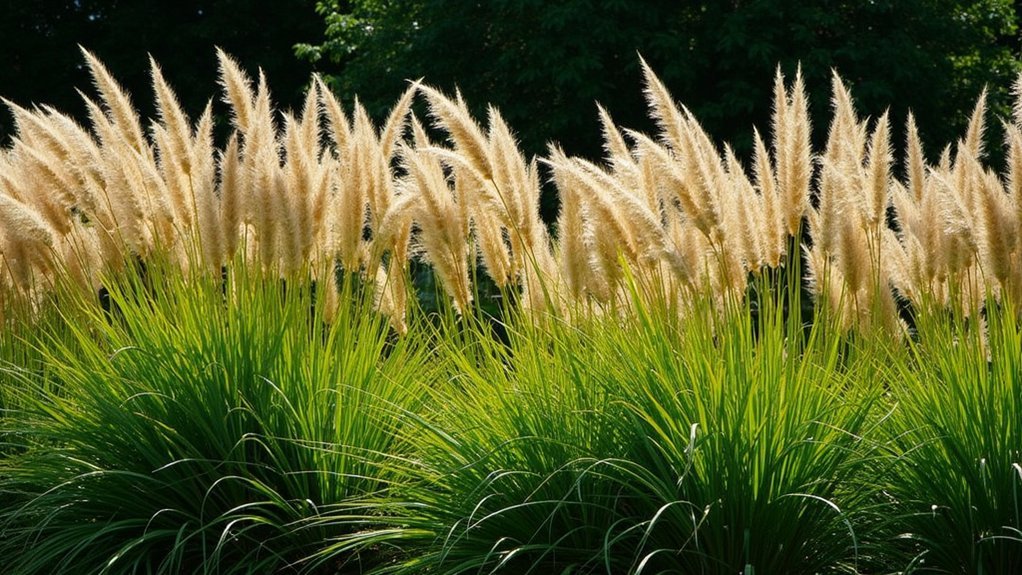
When seeking natural privacy solutions for your landscape, tall ornamental grasses offer an elegant alternative to traditional fencing or hedges.
Zebra Grass creates effective privacy hedges reaching 5-8 feet tall with minimal watering needs once established. For maximum height, consider Hardy Clumping Bamboo, which towers up to 17 feet and provides dense coverage—just choose varieties carefully to avoid invasiveness.
Pampas Grass delivers dramatic tall screens at 8-12 feet, though it can become invasive in mild climates.
Feather Reed Grass forms dense 5-foot clumps with erect foliage but requires more moisture. For adaptability, Switchgrass reaches 3-6 feet in various soil conditions while supporting wildlife with its attractive plumes.
Each option offers a unique combination of height, density, and maintenance requirements to suit your specific screening needs.
Zebra Grass: Nature’s Striped Privacy Solution
Zebra Grass offers you striking vertical growth that creates a natural privacy screen up to 8 feet tall, while requiring minimal care once established.
You’ll appreciate its low-maintenance nature, needing only annual composting and occasional pruning to maintain its dense, screening effect.
The distinctive horizontal cream stripes on deep green blades provide year-round visual interest, transforming from summer’s upright elegance to winter’s golden-bronze plumes that catch the light beautifully.
Striking Vertical Growth
For homeowners seeking both privacy and visual interest, Miscanthus sinensis Zebrinus stands as a remarkable solution. This tall ornamental grass reaches impressive heights of 5 to 8 feet, creating an effective natural screening barrier for your outdoor spaces.
What makes Zebra Grass truly special is its striking vertical growth pattern combined with distinctive horizontal striping. The clumping habit guarantees it remains contained while still spreading 4 to 6 feet wide, perfect for creating continuous privacy screens without becoming invasive.
You’ll appreciate its drought tolerance once established, requiring minimal maintenance beyond an annual late-winter cutback.
The visual interest extends through multiple seasons—vertical summer growth transforms into golden autumn plumes that persist through winter. For homeowners in zones 4-9, this versatile grass delivers the perfect blend of privacy and aesthetic appeal.
Low-Maintenance Privacy Shield
Creating a privacy shield in your garden doesn’t have to involve tedious maintenance routines, thanks to Miscanthus sinensis Zebrinus. This majestic Zebra Grass reaches impressive heights of 5-8 feet with a 4-6 foot spread, effectively blocking unwanted views while adding distinctive visual interest with its striped foliage.
You’ll appreciate how this clumping grass transforms into a low-maintenance privacy screen once established:
- Requires only regular watering during establishment, then minimal attention during dry spells
- Thrives in well-draining soil with neutral pH, adapting easily to most garden conditions
- Needs just an annual compost application to maintain its robust growth and screening capabilities
The dense growth habit of Zebra Grass creates a natural barrier that’s both functional and aesthetically pleasing, offering privacy without the constant upkeep of traditional hedges.
Four-Season Visual Appeal
While most screening plants offer only seasonal interest, Miscanthus sinensis Zebrinus delivers striking visual elements throughout all four seasons.
You’ll enjoy the distinctive green leaves with creamy yellow stripes that provide exceptional visual interest from spring through fall. The clumping habit creates a dense privacy screen reaching 5-8 feet tall and 4-6 feet wide without becoming invasive.
What makes Zebra Grass truly special is its four-season appeal. When temperatures drop, its feathery plumes transform to a beautiful biscuit color, maintaining landscape interest even during winter.
This low-maintenance option requires only regular watering during establishment and occasional moisture during dry spells. By incorporating Zebra Grass into your landscape design, you’ll create an effective, aesthetically pleasing boundary that performs beautifully year-round.
Hardy Clumping Bamboo: Contained Elegance for Boundaries
When privacy meets elegance in the garden, Hardy Clumping Bamboo stands as a superior screening option that won’t take over your yard.
Elegance meets practicality with clumping bamboo—natural screening that respects your boundaries while elevating your landscape.
Reaching impressive heights of up to 17 feet, this cold-hardy variety creates an attractive boundary while its clumping growth habit guarantees controlled spread, unlike invasive running bamboo types.
You’ll find this bamboo thrives in moist, well-draining soil without demanding much attention once established. Its adaptability to various climates makes it an excellent choice for privacy screens in different garden settings.
- Requires moderate moisture during establishment but becomes low maintenance afterward, eliminating the need for fertilizers
- Creates dense, vertical screening that provides year-round privacy
- Natural clumping behavior contains growth, making it manageable while still delivering dramatic height and presence
Pampas Grass: Dramatic Plumes for Maximum Coverage
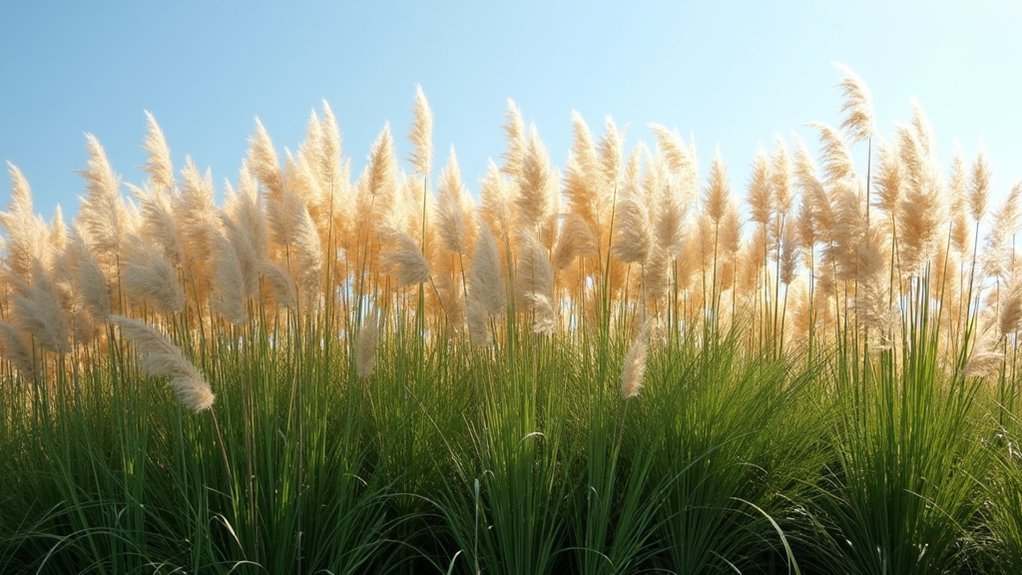
Towering silhouettes of Pampas Grass transform ordinary garden boundaries into spectacular privacy screens. At 8-12 feet tall, Cortaderia selloana creates an impressive living wall with its signature feathery flower plumes in cream or pink. You’ll appreciate its low-maintenance nature once established, requiring minimal watering in your landscape design.
| Feature | Benefit | Consideration |
|---|---|---|
| Height (8-12ft) | Excellent privacy screen | Needs space to grow |
| Feathery plumes | Dramatic visual interest | Seasonal appearance |
| Drought tolerance | Water-efficient | Establish with regular watering |
| Full sun exposure | Adaptable to many settings | Poor shade tolerance |
| Fast growth | Quick screening solution | Can become invasive |
For best results, plant in well-draining soil with full sun exposure. Monitor growth carefully, as these tall grasses can become invasive in mild climates.
Feather Reed Grass: Vertical Interest With Dense Growth
Feather Reed Grass offers stunning columnar structure that creates an effective natural screen while standing tall at 5 feet with a modest 2-foot spread.
You’ll appreciate how these drought-tolerant stalks maintain their upright habit despite minimal watering once established, though they prefer consistent moisture in rich soils.
Their gold-tipped plumes transform your winter landscape, providing visual interest long after other plants have faded.
Elegant Columnar Structure
Among the most architecturally striking grasses for privacy screens, Calamagrostis x acutiflora (Feather Reed Grass) commands attention with its impressive 5-foot height and slender 2-foot spread.
You’ll appreciate its elegant columnar structure that creates dramatic vertical accents while maintaining a relatively compact footprint in your landscape designs.
The narrow, erect growth habit makes Feather Reed Grass ideal for screening in spaces where width is limited but height is desired. When planted in series, these tall grasses form a sophisticated living wall that catches light beautifully.
- Produces airy flower plumes in early summer that transform from pinkish to golden as seasons progress
- Thrives in rich, moist soils and tolerates clay conditions that challenge other ornamental grasses
- Maintains its striking upright form through winter, providing year-round structure and interest
Drought Tolerant Stalks
While the columnar structure of Feather Reed Grass creates striking visual impact, its drought tolerance once established makes it even more valuable for practical screening purposes.
You’ll appreciate that this 5-foot tall grass requires minimal maintenance after its initial growth phase.
Though Feather Reed Grass needs above-average moisture during establishment, particularly in rich, well-draining soils, it becomes remarkably self-sufficient over time.
Its dense, vertical growth habit produces feathery plumes that enhance privacy while maintaining an elegant profile just 2 feet wide.
This adaptability makes Feather Reed Grass perfect for various landscape designs where you need effective screening without overwhelming space.
Its narrow footprint allows you to create privacy barriers in tighter areas, and its resilience in varying conditions—even tolerating clay soils—ensures your living screen remains vibrant throughout the seasons.
Gold-Tipped Winter Display
The magic of Feather Reed Grass extends well beyond the growing season, transforming into a spectacular gold-tipped winter display that maintains your privacy screen year-round.
Standing about 5 feet tall, this grass creates dense, vertical interest that’s perfect for screening while adding ornamental value to your landscape.
You’ll appreciate Feather Reed Grass for its:
- Adaptability to various conditions, including clay and moist soils, making it versatile for different garden settings
- Stunning feathery plumes that catch the winter light, providing visual interest when many other plants have gone dormant
- Ecological diversity benefits, as it attracts birds to your garden, offering them shelter during colder months
While it’s not drought-tolerant, regular watering will reward you with a robust privacy screen that’s as beautiful in winter as it’s in summer.
Miscanthus Varieties: Year-Round Screening Options
Several varieties of Miscanthus sinensis offer exceptional screening capabilities throughout all seasons. The classic silver grass can reach impressive heights of up to 8 feet, with delicate plumes that provide effective privacy while enhancing your landscape’s visual appeal.
Towering Miscanthus creates living privacy screens while adding elegant movement and year-round interest to your garden design.
If you’re looking for a slightly shorter option, the ‘Gracillimus’ cultivar grows 4-6 feet tall and features elegant foliage that gracefully sways in the breeze.
You’ll appreciate that these grasses thrive in hardiness zones 5-9 and adapt to various soil types as long as they’re well-draining.
What makes miscanthus particularly valuable for screening is its year-round interest. The foliage evolves from lush green in summer to stunning golden hues in fall, maintaining visual impact through winter.
Once established, these drought-tolerant grasses require minimal maintenance, needing only initial regular watering.
Switchgrass: Native Privacy for Diverse Landscapes
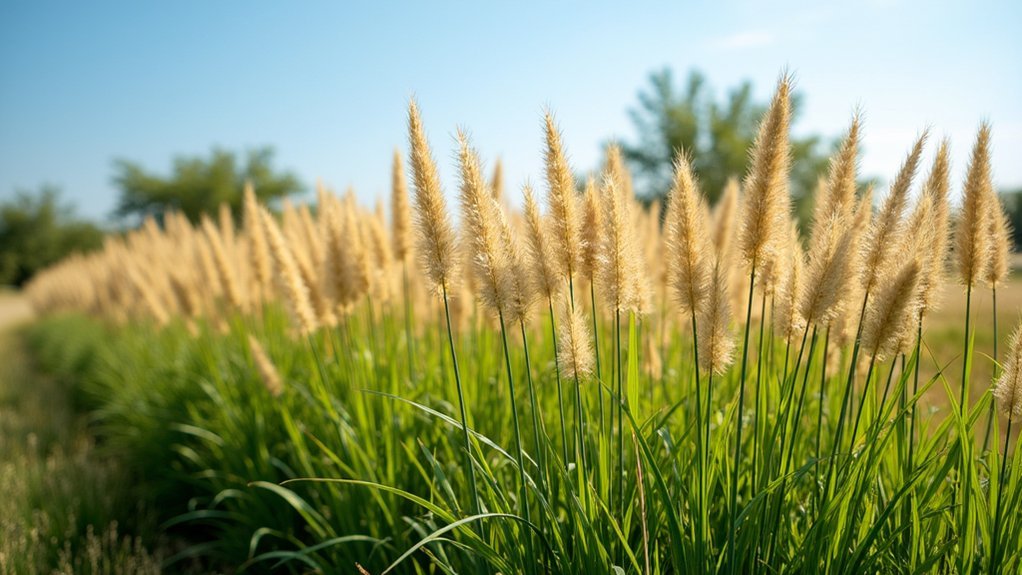
Native to North American prairies, switchgrass offers homeowners an eco-friendly alternative to non-native screening options. Standing 3-9 feet tall, this versatile tall grass creates effective privacy screening while supporting ecological diversity through its wildlife-friendly seed production.
You’ll appreciate its striking visual appeal as blue-green foliage transforms to brilliant orange in autumn, complemented by airy off-white to pink flower panicles.
- Thrives in USDA zones 3-9 and adapts to various soil types, performing well in both moist and dry conditions
- Develops an extensive root system that stabilizes soil while requiring minimal maintenance
- Creates natural movement in your landscape as breezes pass through, adding dynamic visual interest year-round
As a native plant, switchgrass delivers practical screening benefits while enhancing your property’s environmental value—a perfect combination of function and sustainability.
New Zealand Flax: Bold Architectural Screening
Standing boldly as architectural masterpieces in the landscape, New Zealand Flax plants command attention with their dramatic sword-shaped foliage and impressive height of up to 12 feet.
You’ll appreciate the variety of vibrant colors available, from classic green to striking red, copper, and yellow, adding visual dimension to your privacy screen.
This powerhouse performs best in USDA Zones 8-10, preferring medium to rich, well-drained soil that remains consistently moist.
The dense foliage creates an effective privacy barrier while elevating your garden’s aesthetic appeal.
Once established, you’ll find New Zealand Flax remarkably low-maintenance and drought-tolerant, making it a sustainable choice for busy homeowners.
The plant’s upright growth habit helps maximize space while creating the tall, striking screen you’re seeking for boundary definition.
Creating Layered Screens With Mixed Grass Heights

While New Zealand Flax creates a striking single-species screen, you can achieve greater visual interest through layered planting designs.
Combining tall grasses of varying heights creates a dynamic privacy hedge that offers texture, movement, and seasonal color changes.
Try pairing Hardy Clumping Bamboo (17 feet) with Zebra Grass (5-8 feet) for dramatic height variation, or mix Pampas Grass (8-12 feet) with Feather Reed Grass (5 feet) for density and visual complexity.
- Use Japanese Silver Grass (4-6 feet) as a mid-layer shift between taller screening plants and shorter varieties
- Incorporate clumping grasses to maintain defined shapes and prevent invasive spreading in your soil
- Arrange grasses with complementary textures and colors for year-round visual interest, even when dormant
Maintaining Your Grass Privacy Screen
Proper maintenance of your grass privacy screen requires mastering a few key seasonal cutting techniques to encourage healthy growth while controlling height.
You’ll need to implement containment strategies for aggressive spreaders like running bamboo to prevent them from invading unwanted areas of your landscape.
Regular but measured irrigation, especially during establishment and drought periods, will guarantee your living screen remains dense and vibrant throughout the seasons.
Seasonal Cutting Techniques
When your ornamental grass screen has served its purpose through the seasons, it’ll need proper maintenance to continue thriving as an effective privacy barrier.
Seasonal cutting is essential for maintaining your ornamental grasses’ health and screening functionality. The best time for this annual cutting is early spring, just before new growth emerges.
Different grasses require different approaches:
- Cut Pampas Grass to about 12 inches above ground level to protect new shoots while maintaining its privacy screening capabilities.
- Trim Feather Reed Grass and Switchgrass to approximately 6 inches to encourage dense, upright growth.
- Regularly remove dead foliage from varieties like Fountain Grass to improve air circulation and prevent disease.
Preventing Unwanted Spreading
Creating a beautiful grass privacy screen shouldn’t lead to an invasive nightmare in your garden. Select clumping varieties like Zebra Grass or Hardy Clumping Bamboo that naturally maintain their shape without aggressive spreading.
Regularly monitor and prune your grasses to prevent overcrowding and preserve their screening function. Plant them closer together for a denser privacy screen while reducing unwanted expansion.
Install physical barriers—underground root barriers work exceptionally well—to contain invasive species without compromising your screen’s effectiveness.
Proper watering and soil management are essential; stressed plants often become more aggressive. Keep your grasses healthy with consistent care, and they’ll reward you with a well-defined boundary that stays where you want it.
Remember that prevention through thoughtful selection and maintenance is far easier than reclaiming your garden from runaway grasses.
Irrigation Best Practices
Although tall grasses create stunning privacy screens, their long-term success depends heavily on proper irrigation strategies. Your newly planted privacy grasses require frequent watering until established, with species like Zebra Grass needing more moisture than drought-tolerant varieties like Pampas Grass.
- Install a drip irrigation system for efficient watering that promotes deep root development while reducing waste.
- Monitor soil moisture levels regularly, adjusting your watering schedule based on rainfall, temperature, and specific grass requirements.
- Reduce irrigation for established grasses, particularly drought-resistant varieties like Big Bluestem, which need minimal water once mature.
Remember that appropriate watering practices vary by species—Feather Reed and Fountain Grass thrive with above-average moisture during growth periods, while established Hardy Clumping Bamboo requires only moderate irrigation to maintain its privacy screening capabilities.
Climate Considerations for Grass Screen Selection
Selecting the right tall grasses for your privacy screen depends heavily on your local climate conditions. Check your USDA hardiness zones first—Miscanthus sinensis thrives in zones 5-9, while others have different tolerances. For areas with minimal rainfall, choose drought tolerant options like Pampas Grass, which establishes strong screening effectiveness over time.
| Climate Factor | Best Grass Selection |
|---|---|
| Hot, Dry Areas | Pampas Grass, Big Bluestem |
| Wet Regions | Feather Reed Grass |
| Windy Sites | Hardy Clumping Bamboo |
| Cold Climates | Miscanthus varieties (zones 5-9) |
Most tall grasses require full sun exposure to reach their maximum height and density. Soil type matters too—rich, well-draining soil supports better growth, but many grasses adapt to varying moisture conditions. Wind resistance becomes essential in exposed locations.
Fast-Growing Options for Immediate Privacy
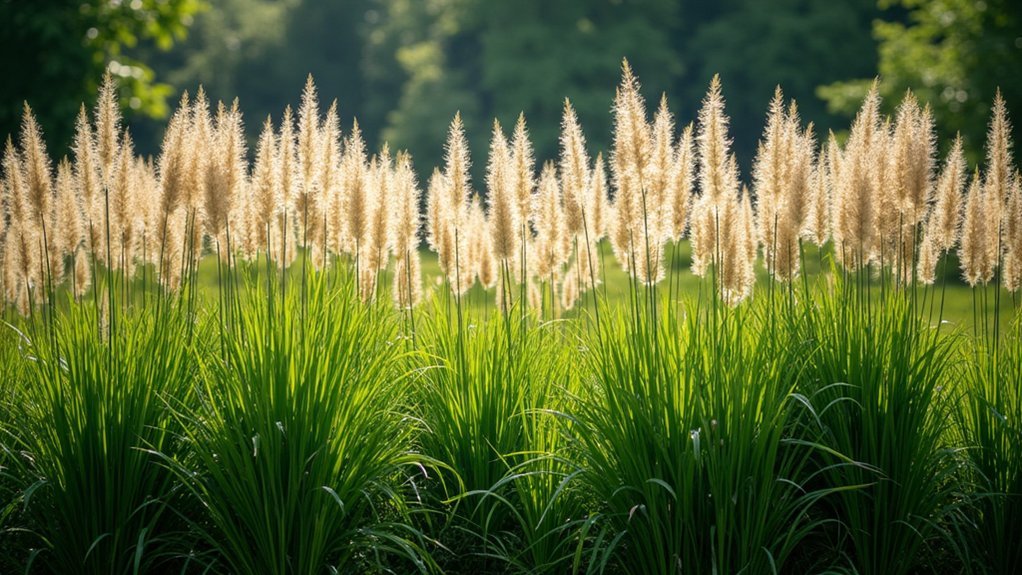
While climate conditions establish the foundation for your grass selection, many homeowners need privacy solutions that work quickly. Several tall grass varieties offer both rapid growth and effective screening capabilities.
When privacy feels urgent, nature offers solutions through fast-growing grasses that create natural, beautiful barriers.
Zebra Grass establishes quickly, reaching 5-8 feet with an attractive clumping habit that creates dense visual barriers. For maximum height, Hardy Clumping Bamboo soars to 17 feet with a fast growth rate while avoiding the invasiveness of running bamboo varieties.
- Pampas Grass delivers dramatic 8-12 foot barriers in record time, though you’ll need to monitor its spread in milder climates.
- Switchgrass adapts to various soil conditions and fills privacy gaps within two growing seasons, reaching 3-9 feet tall.
- Feather Reed Grass provides 5-foot screening in rich, moist soils—perfect for areas with above-average moisture.
Frequently Asked Questions
What Is the Best Tall Ornamental Grass for Full Sun?
For the best tall ornamental grass in full sun, consider Hardy Clumping Bamboo. It’ll give you impressive height up to 17 feet while maintaining a controlled spread due to its clumping growth habit.
What Are the Best Low Maintenance Ornamental Grasses?
For low maintenance ornamental grasses, you’ll love Zebra Grass and Big Bluestem since they need minimal watering once established. Switchgrass is also excellent as it adapts to various conditions with little care required.
What Is a Tall, Strong Grass?
Hardy Clumping Bamboo is your tallest, strongest grass option, reaching up to 17 feet. Pampas Grass is also robust at 8-12 feet tall, while Zebra Grass offers strength and height between 5-8 feet.
What Is the Best Ornamental Grass for Foundation Planting?
For foundation planting, you’ll find Feather Reed Grass ideal with its vertical interest without overwhelming space. Blue Oat Grass offers complementary blue-gray foliage, while Japanese Blood Grass provides vibrant color at a manageable 2-3 foot height.
In Summary
You’ll find the perfect tall grass for your screening needs if you match the variety to your climate and space. Whether you’ve chosen the dramatic plumes of pampas grass or the contained elegance of clumping bamboo, remember to maintain your living privacy screen with annual pruning. With proper care, these natural barriers will provide years of beautiful, functional screening while adding movement and texture to your landscape.

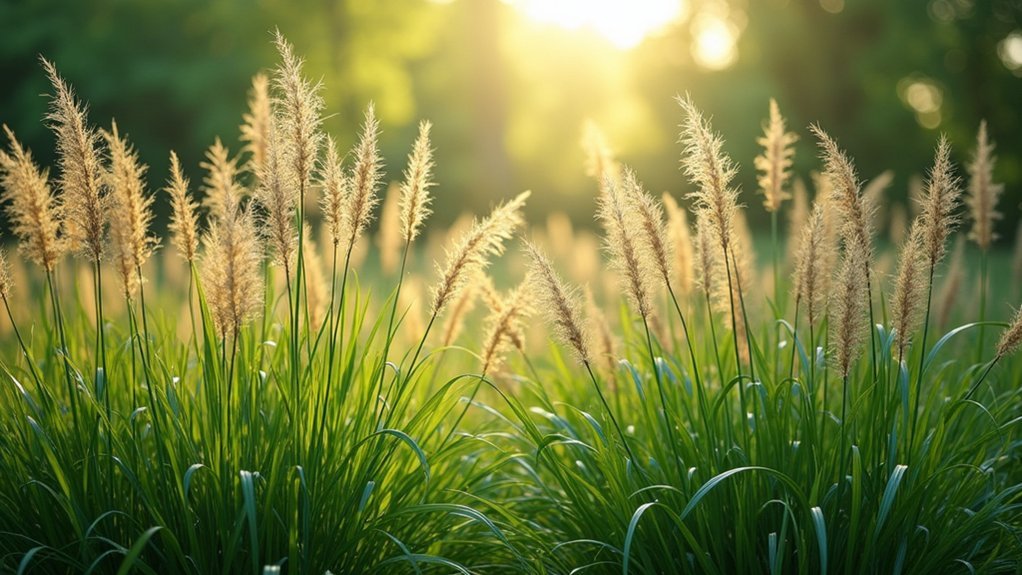

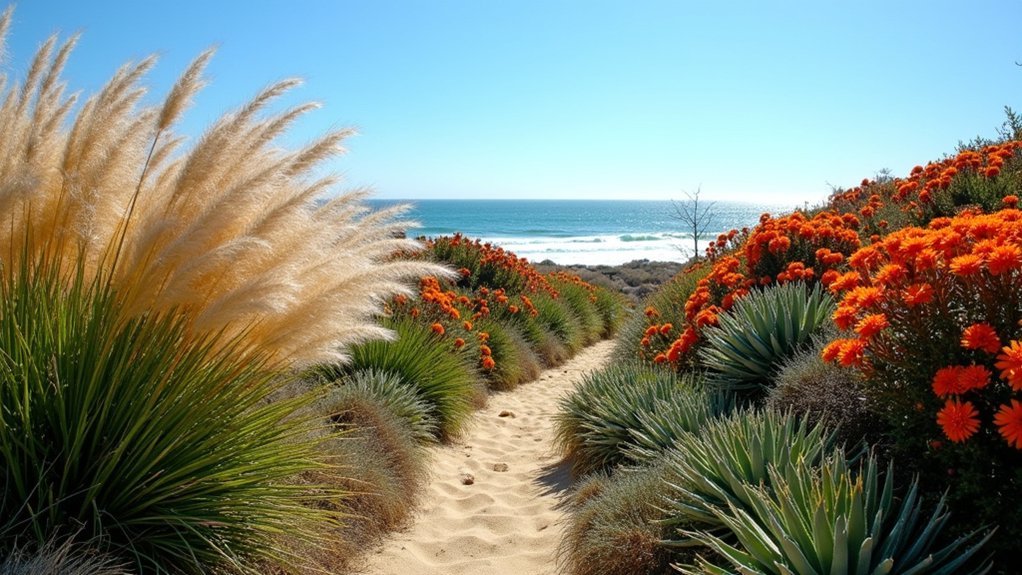
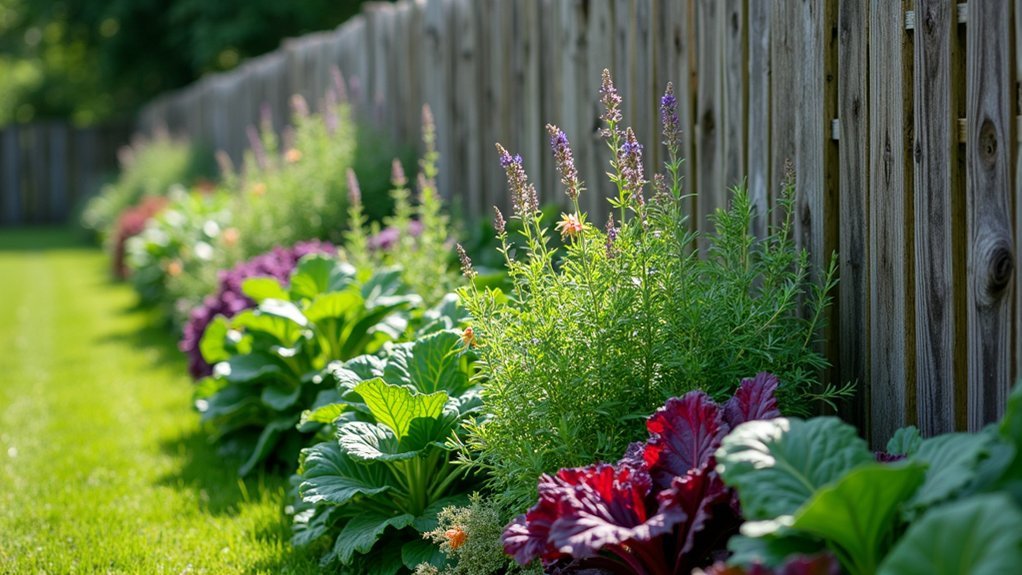
Leave a Reply